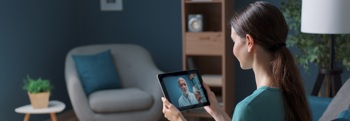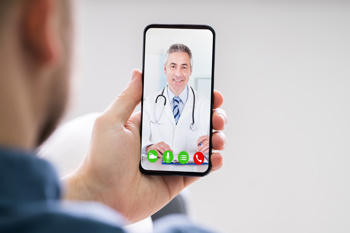
What is a video consultation
Video consultations are when a patient and a doctor hold an appointment remotely, using the camera in a smartphone or a webcam on a laptop or computer to display themselves to each other. The two parties will hold a normal conversation – as they would on a phone call or in person – and the usual levels of discretion and privacy are guaranteed.
Video consultations in primary care are the most common, being the first port of call contact between a person and a clinician, with GP surgeries being the most common of all primary care scenarios utilising a healthcare video consultation.
.
Community care video consultation
Consultations also exist outside of primary care. Community care plays an important and ongoing role in a person’s life when they are managing conditions. Also referred to as telehealth, or a ‘video visit’, these video calls are designed as an alternative that can account for things such as high demand on a clinician, adverse weather, or a person’s poor health; where the effort of a physical appointment might be too much – despite the benefits of having an appointment.
Video consultations in community care allow for flexibility between the client and the clinician to ensure regular contact and updates. This builds familiarity and comfort between the parties, but also ensures that medical information is highly accurate and able to indicate any early warnings signs for a person’s GP to investigate.
Video consultations in Mental Health care
Mental health care is a very sensitive and important area of healthcare. Patients are often under duress and need regular, reliable contact with a clinician. Face-to-face appointments are often in short supply, and there’s also a travel issue for vulnerable patients who don’t have the capability to attend.
Video consultation offers the best of both worlds; body language and visible cues between the patient and clinician, and a way of remaining in the comfort, safety or familiarity of home whilst still engaging in the care.
NHS England’s Transformation Directorate uses Berkshire Healthcare NHS Foundation Trust (BHFT) as a case study for why video consultation is beneficial in mental health care. They reported a reduction in waiting times, easier access for new and existing patients to the trust’s mental health services, and the flexibility to accommodate both patient and clinician around personal or work schedules. These benefits notably reduced ‘did not attend’ (DNA) outcomes for appointments, which brings more cost-efficiency with no rebooking of appointments, and further opens up availability of services.
It will be interesting to discover in the future by what percentage the DNAs improved and if there’s any metric of showing an impact of prevention of mental health incidents thanks to these calls.

How to do a video consultation
So, how does a video consultation work?
Your GP surgery or local NHS trust will offer you the option of a remote appointment via video. This video consultation will take place at a set time, like any other appointment, but there will be instructions as to where the call will take place virtually. This could be on a specific website page for you and the clinician, such as a Zoom or Google call.
More likely is that it will be through an app. NHS services and GP practices have lots of patient portal applications where users can log in to check their medical records, prescriptions, and appointments. Many of these solutions also support video consultations, and they’re considered more secure for data and privacy.
To recap, for a video consultation you will need:
- A device to make the call on. This can be a smartphone, laptop, tablet, or computer. Phones and tablets are the most common because they have built-in cameras and microphones.
- Internet (Wi-Fi or mobile data)
- To be in a suitable location for a private call, where you and the doctor or nurse can clearly see each other and hear each other.
The instructions for joining the video consultation call will usually be stated on the application as you log in, and often is as simple as clicking a button saying something like ‘Join Call’ or ‘Join Meeting’.
Please note: if it is your first time using the software you may be prompted on the screen to allow the device to use your camera and microphone. You should approve this request so the software can properly function. Once done, the call should work immediately.
Pros and cons of video consultations
The benefits of video consultation largely outweigh the drawbacks, but it’s important to highlight both. The British Medical Journal launched their Virtual online consultations: advantages and limitations (VOCAL) study in 2015. They flagged up potential issues with visual cues and whether a video consultation is closer to a phone call rather than an in-person meeting.
The reality of the eight years since then has proven that it is nearer the face-to-face meetings. For the patient, it’s the same crucial face time to discuss their health, but it’s also a time-saver thanks to the convenience of not needing to travel.
With no travel demands and cost omitted, there’s greater incentive to be present. GP surgeries are beset by delays with late patients, longer than planned appointments, and even failures to show. By adding in some video calls we the public can help save time and allow more flexibility for the patients going in person and the accommodation of them.
For the doctor, healthcare video consultation is a way of safeguarding the clinician from common illnesses like coughs, colds and other viral bugs so that they can continue their important work. We’ve also covered the time efficiency benefits too, but this has more of an impact than just accommodating patients. Healthcare professionals are undeniably overworked. Burnout and stress issues are very common, and the turnover of staff within healthcare is speeding up. By carving out more time for doctors and nurses to see patients and to do their work we’ve alleviating this stress and reducing the need to eat into personal hours; the crucial time for any staff member in any industry to relax and reset so they can begin anew the next day or the next shift.

Is online medical consultation a good idea
To conclude this article we have to ask if video consultation is a good idea, and we can gauge that with the opinions of the Royal College of General Practitioners (RCGP) and the General Medical Council (GMC).
RCGP video consultation
The Royal College of General Practitioners (RCGP) is broadly supportive of the new video call technology and using it for video consultation, but they do add the below as a particular caveat for usage:
You must be satisfied that the image or remote examination is necessary and justified, will be of benefit to the patient and is in their best interests. Use your clinical judgement and assess patients on a case by case basis.
The foundations of their viewpoint are that a clinician can utilise video consultations so long as they are safe, consensual, and enforce proper privacy and data protection measures to make the video interaction equal to an in-office appointment as a surgery or clinic.
GMC video consultations
The General Medical Council (GMC) also supports video consultation, though they too offer somewhat similar advice in a three-point list for how to handle them:
- Good practice standards should apply to all appointments.
- If you can’t safely prescribe remotely, don’t.
- The type of appointment should be agreed with the patient, not decided.
This again comes down to consent, but also touches upon patient preference. The NHS and other services are tailoring themselves more to be accommodating and flexible; a more personalised service for a client, rather than an rigid system that demands your obedience as the patient.
Our conclusion then is yes, digital-first online consultation and video consultation are good as concepts and in practice – provided that they are not skipping any of the vital safeguarding measures for the individual nor any of the data protection measures that apply in cases of digital healthcare. If a healthcare provider can guarantee both of these, and have the consent of the patient, then there’s no reason why not to use video consultations and plenty of time savings to be gained.

 AU & NZ
AU & NZ
 SG
SG
 MY
MY
 US
US
 IE
IE

